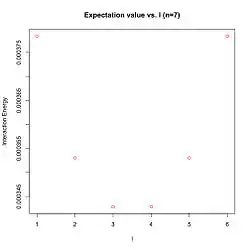Laughlin wavefunction
In condensed matter physics, the Laughlin wavefunction[1][2] is an ansatz, proposed by Robert Laughlin for the ground state of a two-dimensional electron gas placed in a uniform background magnetic field in the presence of a uniform jellium background when the filling factor (Quantum Hall effect) of the lowest Landau level is where is an odd positive integer. It was constructed to explain the observation of the fractional quantum Hall effect, and predicted the existence of additional states as well as quasiparticle excitations with fractional electric charge , both of which were later experimentally observed. Laughlin received one third of the Nobel Prize in Physics in 1998 for this discovery. Being a trial wavefunction, it is not exact, but qualitatively, it reproduces many features of the exact solution and quantitatively, it has very high overlaps with the exact ground state for small systems.
If we ignore the jellium and mutual Coulomb repulsion between the electrons as a zeroth order approximation, we have an infinitely degenerate lowest Landau level (LLL) and with a filling factor of 1/n, we'd expect that all of the electrons would lie in the LLL. Turning on the interactions, we can make the approximation that all of the electrons lie in the LLL. If is the single particle wavefunction of the LLL state with the lowest orbital angular momenta, then the Laughlin ansatz for the multiparticle wavefunction is
where position is denoted by
in (Gaussian units)
and and are coordinates in the xy plane. Here is Planck's constant, is the electron charge, is the total number of particles, and is the magnetic field, which is perpendicular to the xy plane. The subscripts on z identify the particle. In order for the wavefunction to describe fermions, n must be an odd integer. This forces the wavefunction to be antisymmetric under particle interchange. The angular momentum for this state is .
Energy of interaction for two particles

The Laughlin wavefunction is the multiparticle wavefunction for quasiparticles. The expectation value of the interaction energy for a pair of quasiparticles is
where the screened potential is (see Coulomb potential between two current loops embedded in a magnetic field)
where is a confluent hypergeometric function and is a Bessel function of the first kind. Here, is the distance between the centers of two current loops, is the magnitude of the electron charge, is the quantum version of the Larmor radius, and is the thickness of the electron gas in the direction of the magnetic field. The angular momenta of the two individual current loops are and where . The inverse screening length is given by (Gaussian units)
where is the cyclotron frequency, and is the area of the electron gas in the xy plane.
The interaction energy evaluates to:

To obtain this result we have made the change of integration variables
and
and noted (see Common integrals in quantum field theory)
The interaction energy has minima for (Figure 1)
and
For these values of the ratio of angular momenta, the energy is plotted in Figure 2 as a function of .
References
- Laughlin, R. B. (2 May 1983). "Anomalous Quantum Hall Effect: An Incompressible Quantum Fluid with Fractionally Charged Excitations". Physical Review Letters. American Physical Society (APS). 50 (18): 1395–1398. doi:10.1103/physrevlett.50.1395. ISSN 0031-9007.
- Z. F. Ezewa (2008). Quantum Hall Effects, Second Edition. World Scientific. ISBN 978-981-270-032-2. pp. 210-213
